Study on the Influence of the Strain-Softening of the Surrounding Rock with Buried Depth on Gas Extraction Boreholes
Abstract
1. Introduction
2. The S-S Model of the Surrounding Rock of Boreholes
3. Evolution Equations of Permeability and Equations of Gas Migration in the Surrounding Rock of Boreholes
3.1. Permeability Evolution Equations
3.2. Equations of Gas Migration
4. The Influence of the S-S Phenomenon of the Surrounding Rock on Extraction Boreholes with Buried Depth
4.1. Influence of the S-S Phenomenon of the Surrounding Rock of Boreholes on the Stress Distribution with Buried Depth
4.2. Influence of the S-S Phenomenon of the Surrounding Rock of Boreholes on the Permeability Distribution with Buried Depth
4.3. Influence of the S-S Phenomenon of the Surrounding Rock of Boreholes on the Distribution of Gas Pressure with Buried Depth
5. Discussion
6. Conclusions
- (1)
- We established the models of gas extraction at different buried depths according to the S-S model, which is more realistic in the field, and combined it with the evolution equations of permeability and the equations of gas migration based on the analysis of the shortcomings of the M-C constitutive model for simulating the excavation problems. Then, the results were compared with the M-C constitutive model.
- (2)
- The permeability of the surrounding rock of boreholes is sensitive to the buried depth and the strain-softening. The maximum permeability ratios obtained from the M-C constitutive model and the S-S model were 1.37 and 2.06, 6.88 and 291.23, and 97.56 and 3629.66 for buried depths of 300, 500, and 700 m, respectively. When the buried depths were 300, 500, and 700 m, the increases in the width of the zone of permeability obtained from the strain-softening model at the above depths were 31.3, 39.6, and 43.9 mm larger than those obtained from the Mohr–Coulomb constitutive model, respectively.
- (3)
- The influence of the S-S phenomenon of the surrounding rock on the distribution of the gas pressure and the effective extraction radius of gas boreholes increases with the increase in the buried depth. At the same buried depth, the gas pressure curves obtained from the S-S model were below those obtained from M-C constitutive model. A slowly increasing zone of gas pressure will appear near the borehole’s boundary with the increase in the buried depth, and the slowly increasing zone of gas pressure obtained from the S-S model is more obvious than that obtained from the M-C constitutive model. The differences in the effective extraction radius of gas boreholes obtained from the S-S model and the M-C constitutive model also increase gradually with the increase in the buried depth: which are 11.8, 47.1, and 80.8 mm for buried depths of 300, 500, and 700 m, respectively.
- (4)
- The results of this research show that the influence of the S-S phenomenon of the surrounding rock of boreholes is more significant with the increase in the buried depth; that is, the strain-softening has an obvious buried depth effect. When the buried depth is shallow (no more than 300 m under the coal seam parameters in this paper), the permeability, gas pressure, and effective extraction radius of the borehole obtained from the M-C constitutive model and the S-S model are not significantly different, and the S-S phenomenon of the surrounding rock of the borehole can be ignored. It is increasingly necessary to consider the S-S phenomenon of the surrounding rock of boreholes with the increase in the buried depth when studying gas extraction boreholes.
Author Contributions
Funding
Data Availability Statement
Acknowledgments
Conflicts of Interest
References
- Wang, L.; Liu, S.; Cheng, Y.; Yin, G.; Zhang, D.; Guo, P. Reservoir reconstruction technologies for coalbed methane recovery in deep and multiple seams. Int. J. Min. Sci. Technol. 2017, 27, 277–284. [Google Scholar] [CrossRef]
- Xie, H.; Ju, Y.; Ren, S.; Gao, F.; Liu, J.; Zhu, Y. Theoretical and technological exploration of deep in situ fluidized coal mining. Front. Energy 2019, 13, 603–611. [Google Scholar] [CrossRef]
- Kang, H.; Jiang, P.; Huang, B.; Guan, X.; Wang, Z.; Wu, Y.; Gao, F.; Yang, J.; Cheng, L.; Zheng, Y.; et al. Roadway strata control technology by means of bolting-modification-destressing in synergy in 1000m deep coal mines. J. China Coal Soc. 2020, 45, 845–864. [Google Scholar]
- Jing, H.; Meng, Q.; Zhu, J.; Meng, B.; Yu, L. Theoretical and technical progress of stability control of broken rock zone of deep roadway surrounding rock. J. Min. Saf. Eng. 2020, 37, 429–442. [Google Scholar]
- Cheng, L.; Kang, H.; Jiang, P.; Li, W.; Yang, J.; Zheng, Y.; Yi, K. Deformation and failure characteristics and control technology of surrounding rocks in deeply gob-side entry driving. J. Min. Saf. Eng. 2021, 38, 227–236. [Google Scholar]
- Sun, H.; Dai, L.; Lu, J.; Cao, J.; Li, M. Analyzing energy transfer mechanism during coal and gas protrusion in deep mines. Processes 2022, 10, 2634. [Google Scholar] [CrossRef]
- Yuan, L. Strategic thinking of simultaneous exploitation of coal and gas in deep mining. J. China Coal Soc. 2016, 41, 1–6. [Google Scholar]
- Zhou, F.; Sun, Y.; Li, H.; Yu, G. Research on the theoretical model and engineering technology of the coal seam gas drainage hole sealing. J. China Univ. Min. Technol. 2016, 45, 433–439. [Google Scholar]
- Xu, C.; Wang, J.; Du, C.; Zhou, A.; Wang, K. Simulation of attenuation mechanism of negative pressure along the hole length of long boreholes in gas drainage and its influencing factors. J. Min. Saf. Eng. 2021, 38, 419–428. [Google Scholar]
- Hook, M.; Tang, X. Depletion of fossil fuels and anthropogenic climate changed: A review. Energy Policy 2013, 52, 797–809. [Google Scholar] [CrossRef]
- Wang, L.; Cheng, Y. Drainage and utilization of Chinese coal mine methane with a coal methane co-exploitation model: Analysis and projections. Resour. Policy 2012, 37, 315–321. [Google Scholar] [CrossRef]
- Gao, Y.; Lin, B.; Yang, W.; Li, Z.; Pang, Y.; Li, H. Drilling large diameter cross-measure boreholes to improve gas drainage in highly gassy soft coal seams. J. Nat. Gas Sci. Eng. 2015, 26, 193–204. [Google Scholar] [CrossRef]
- Zhang, Y.; Meng, Z.; Qin, Y.; Zhang, Z.; Zhao, Y.; Qiu, A. Innovative engineering practice of soft coal seam permeability enhancement by controllable shock wave for mine gas extraction: A case of Zhongjing Mine, Shuicheng, Guizhou Province, China. J. China Coal Soc. 2019, 44, 2388–2400. [Google Scholar]
- Xu, H.; Wang, G.; Guo, Y.; Chang, B.; Hu, Y.; Fan, J. Theoretical, numerical, and experimental analysis of effective extraction radius of coalbed methane boreholes by a gas seepage model based on defined criteria. Energy Sci. Eng. 2020, 8, 880–897. [Google Scholar] [CrossRef]
- Qi, Q.; Jia, X.; Zhou, X.; Zhao, Y. Instability-negative pressure loss model of gas drainage borehole and prevention technique: A case study. PLoS ONE 2020, 15, e0242719. [Google Scholar] [CrossRef]
- Cao, Z.; Wang, E.; He, X.; Wang, H.; Liu, Q.; Zhang, G.; Luo, F.; Wang, C.; Xu, Y. Effect evaluation of pressure relief and gas drainage of hydraulic punching in short-distance coal seam group with the risk of outburst. J. Min. Saf. Eng. 2021, 38, 634–642. [Google Scholar]
- Xie, S.; Cui, J.; Chen, D.; Chen, P. Numerical simulation study on gas drainage by interval hydraulic flushing in coal seam working face. Energy Explor. Exploit. 2021, 39, 1123–1142. [Google Scholar] [CrossRef]
- Zhang, X.; Shen, S.; Feng, X.; Ming, Y.; Liu, J. Influence of deformation and instability of borehole on gas extraction in deep mining soft coal seam. Adv. Civ. Eng. 2021, 2021, 6689277. [Google Scholar] [CrossRef]
- Chen, D.; Wang, J.; Jia, B.; Xi, J. High-efficiency regional gas drainage model after hydraulic fracturing of comb-shaped long boreholes in the roof of broken soft and low permeability coal seam. Coal Geol. Explor. 2022, 50, 29–36. [Google Scholar]
- Ren, P.; Liu, Y.; Han, H.; Wang, D.; Zuo, W.; Li, Y.; Shi, C. Study on influence laws of coal flushing rate on coal seam stress relief and gas extraction. Coal Sci. Technol. 2022, 50, 102–109. [Google Scholar]
- Zhang, X.; Zhou, F.; Zou, J. Numerical simulation of gas extraction in coal seam strengthened by static blasting. Sustainability 2022, 14, 12484. [Google Scholar] [CrossRef]
- Kang, Y.; Geng, Z.; Liu, B.; Chen, J. Study on gas extraction efficiency using in-seam borehole method considering influence of plastic zone induced by borehole drilling. Geomech. Energy Environ. 2023, 33, 100426. [Google Scholar] [CrossRef]
- Du, F.; Cui, W.; Wang, K. Study on Gas migration mechanism and multi-borehole spacing optimization in coal under negative pressure extraction. Processes 2023, 11, 259. [Google Scholar] [CrossRef]
- Zhou, J.; Xu, W.; Li, M.; Zhou, X.; Shi, C. Application of rock strain softening model to numerical analysis of deep tunnel. Chin. J. Rock Mech. Eng. 2009, 28, 1116–1127. [Google Scholar]
- Leandro, A.; Alfonso, R.; Maria, V. Plastic radii and longitudinal deformation profiles of tunnels excavated in strain-softening rock masses. Tunn. Undergr. Space Technol. 2012, 30, 169–192. [Google Scholar]
- Cao, R.; Cao, P.; Zhang, K.; Lin, H. Stability analysis of roadway intersection considering strain softening. Rock Soil Mech. 2013, 34, 73–77. [Google Scholar]
- Hou, Y.; Cui, J.; Liu, R. Study on the long-distance gas pre-drainage technology in the heading face by directional long borehole. Energies 2022, 15, 6304. [Google Scholar] [CrossRef]
- Jing, W.; Xue, W.; Yao, Z. Variation of the internal friction angle and cohesion of the plastic softening zone rock in roadway surrounding rock. J. China Coal Soc. 2018, 43, 2203–2210. [Google Scholar]
- González-Cao, J.; Varas, F.; Bastante, F.; Alejano, L. Ground reaction curves for circular excavations in non-homogeneous, axisymmetric strain-softening rock masses. J. Rock Mech. Geotech. 2013, 5, 431–442. [Google Scholar] [CrossRef]
- Alonso, E.; Alejano, L.; Varas, F.; Fdez-Manin, G.; Carranza-Torres, C. Ground response curves for rock masses exhibiting strain-softening behaviour. Int. J. Numer. Anal. Methods Geomech. 2003, 27, 1153–1185. [Google Scholar] [CrossRef]
- Cui, J.; Hou, Y.; Xie, S.; Chen, D.; Yan, X.; Meng, S. Study on the effect of strain-softening on permeability and gas pressure in surrounding rocks of a hydraulic flushing borehole. ACS Omega 2002, 8, 15501–15517. [Google Scholar] [CrossRef]
- Zhang, L.; Zhou, H.; Wang, X.; Rong, T.; Chen, C. Characteristics of deep coalbed gas migration based on the time-dependent effect. J. China Coal Soc. 2019, 44, 1771–1779. [Google Scholar]
- Mora, C.; Wattenbarger, R. Analysis and verification of dual porosity and CBM shape factors. J. Can. Pet. Technol. 2009, 48, 17–21. [Google Scholar] [CrossRef]
- Liu, Q.; Cheng, Y.; Wang, H.; Zhou, H.; Liang, W.; Wei, L.; Liu, H. Numerical assessment of the effect of equilibration time on coal permeability evolution characteristics. Fuel 2015, 140, 81–89. [Google Scholar] [CrossRef]
- Yuan, X.; Liang, B.; Sun, W.; Zhang, X. Research on permeability evolution model for coal seam being drained by pressure relief. China Saf. Sci. J. 2016, 26, 127–131. [Google Scholar]
- Tu, Q.; Cheng, Y.; Liu, Q.; Guo, P.; Wang, L.; Li, W.; Jiang, J. Investigation of the formation mechanism of coal spallation through the cross-coupling relations of multiple physical processes. Int. J. Rock Mech. Min. Sci. 2018, 105, 133–144. [Google Scholar] [CrossRef]
- Kong, X.; Wang, E.; Liu, X.; Li, N.; Chen, L.; Feng, J.; Kong, B.; Li, D.; Liu, Q. Coupled analysis about multi-factors to the effective influence radius of hydraulic flushing: Application of response surface methodology. J. Nat. Gas Sci. Eng. 2016, 32, 538–548. [Google Scholar] [CrossRef]
- Zhang, H.; Cheng, Y.; Liu, Q.; Yuan, L.; Dong, J.; Wang, L.; Qi, Y.; Wang, W. A novel in-seam borehole hydraulic flushing gas extraction technology in the heading face: Enhanced permeability mechanism, gas flow characteristics, and application. J. Nat. Gas Sci. Eng. 2017, 46, 498–514. [Google Scholar] [CrossRef]
- Liu, S.; Ma, G.; Lu, J.; Lin, B. Relative pressure determination technology for effective radius found on gas content. J. China Coal Soc. 2011, 36, 1715–1719. [Google Scholar]
- Xie, H.; Gao, F.; Ju, Y. Research and development of rock mechanics in deep ground engineering. Chin. J. Rock Mech. Eng. 2015, 34, 2161–2178. [Google Scholar]
- Huang, B.; Zhang, N.; Jing, H.; Kan, J.; Meng, B.; Li, N.; Xie, W.; Jiao, J. Large deformation theory of rheology and structural instability of the surrounding rock in deep mining roadway. J. China Coal Soc. 2020, 45, 911–926. [Google Scholar]


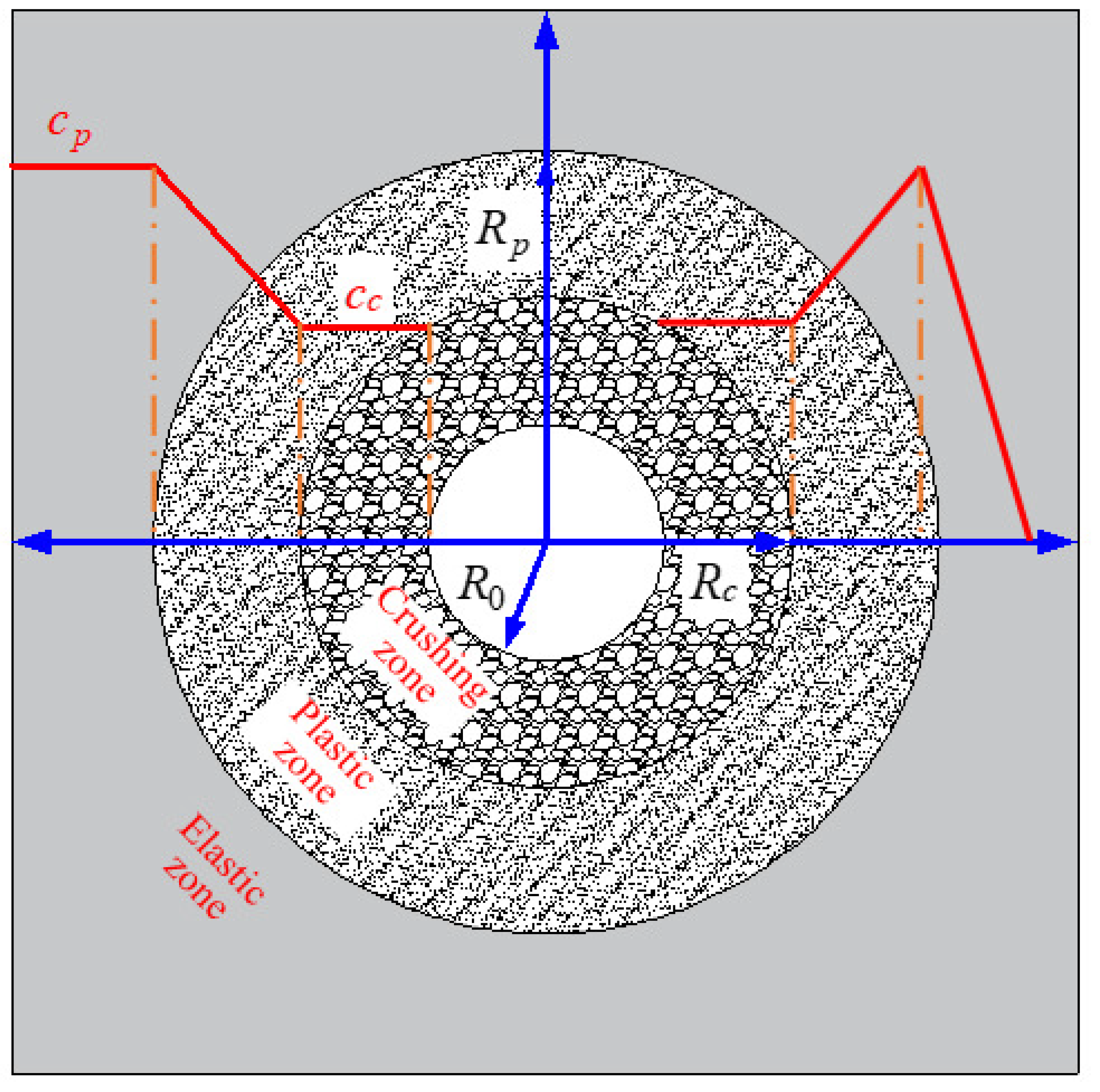
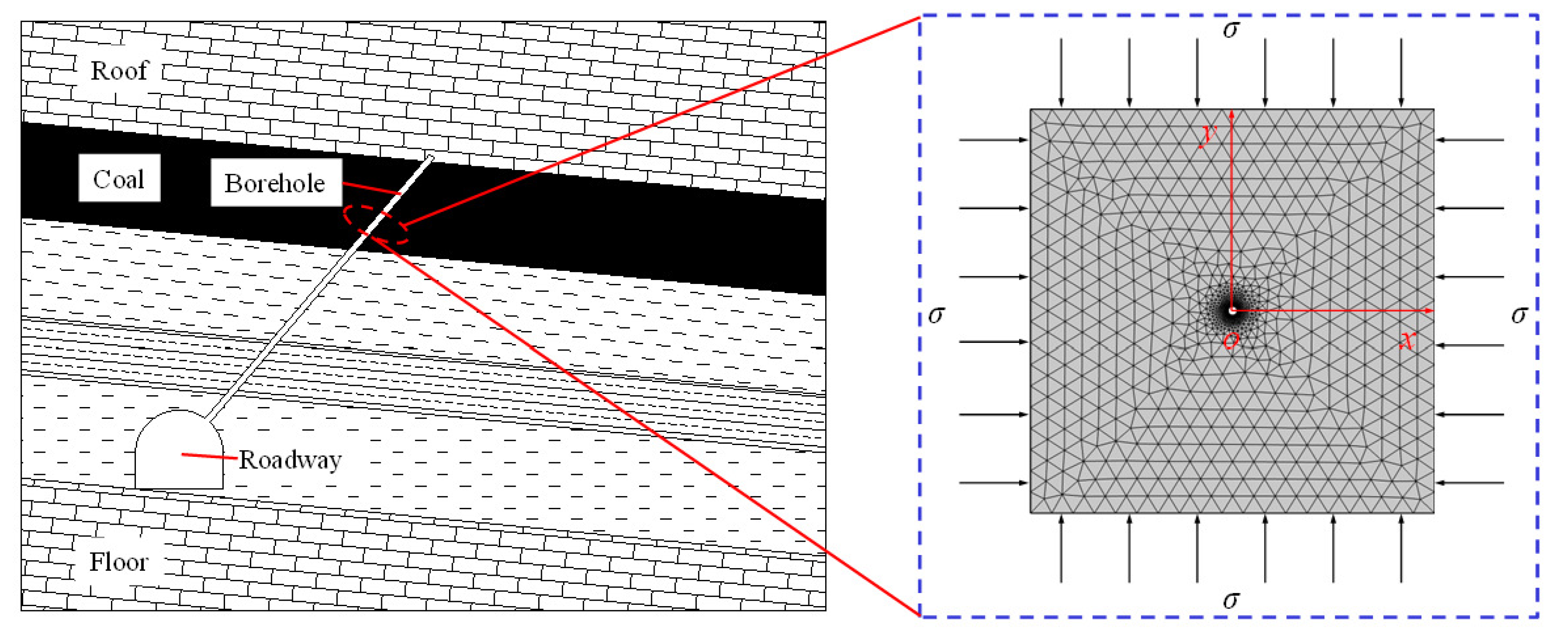


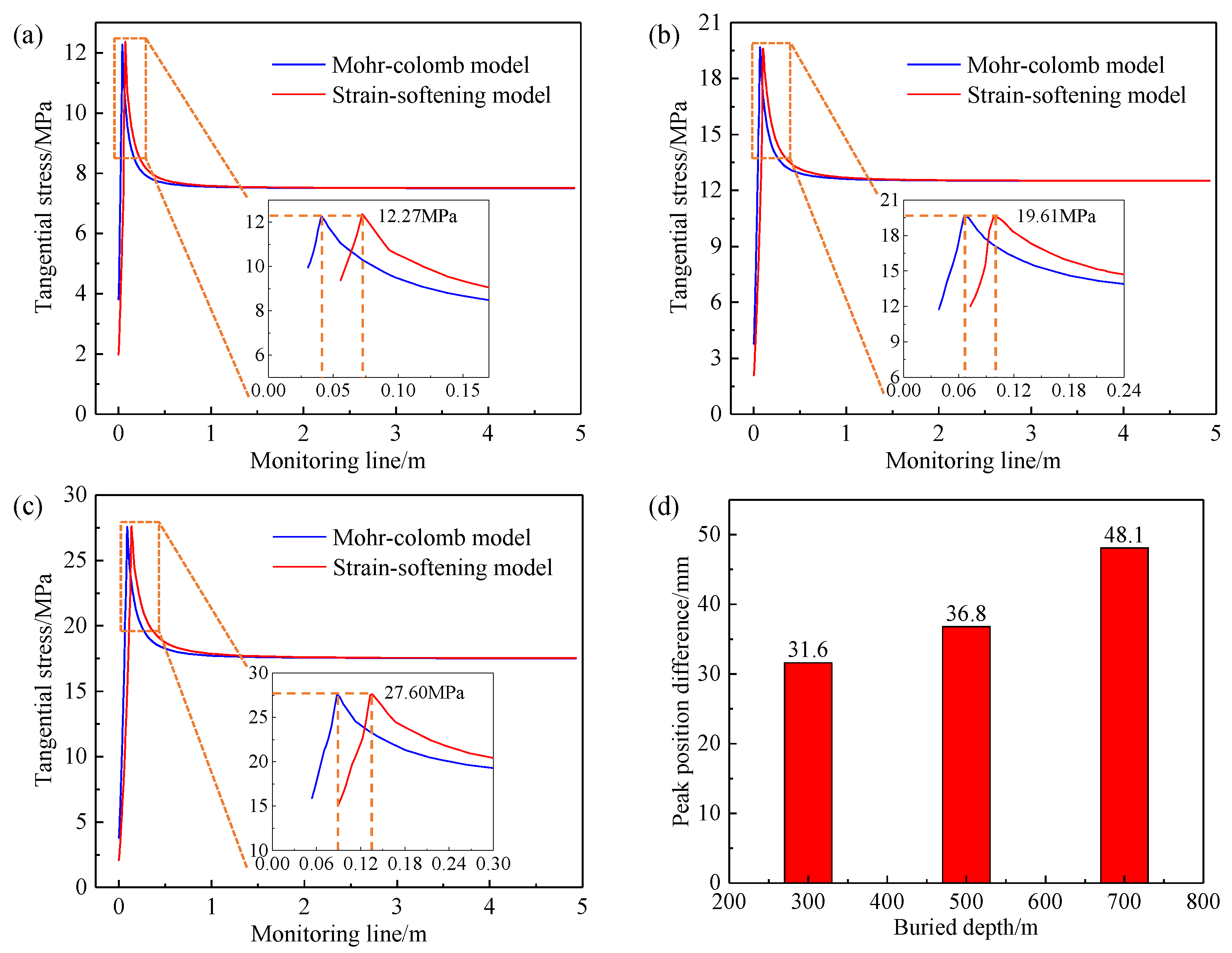





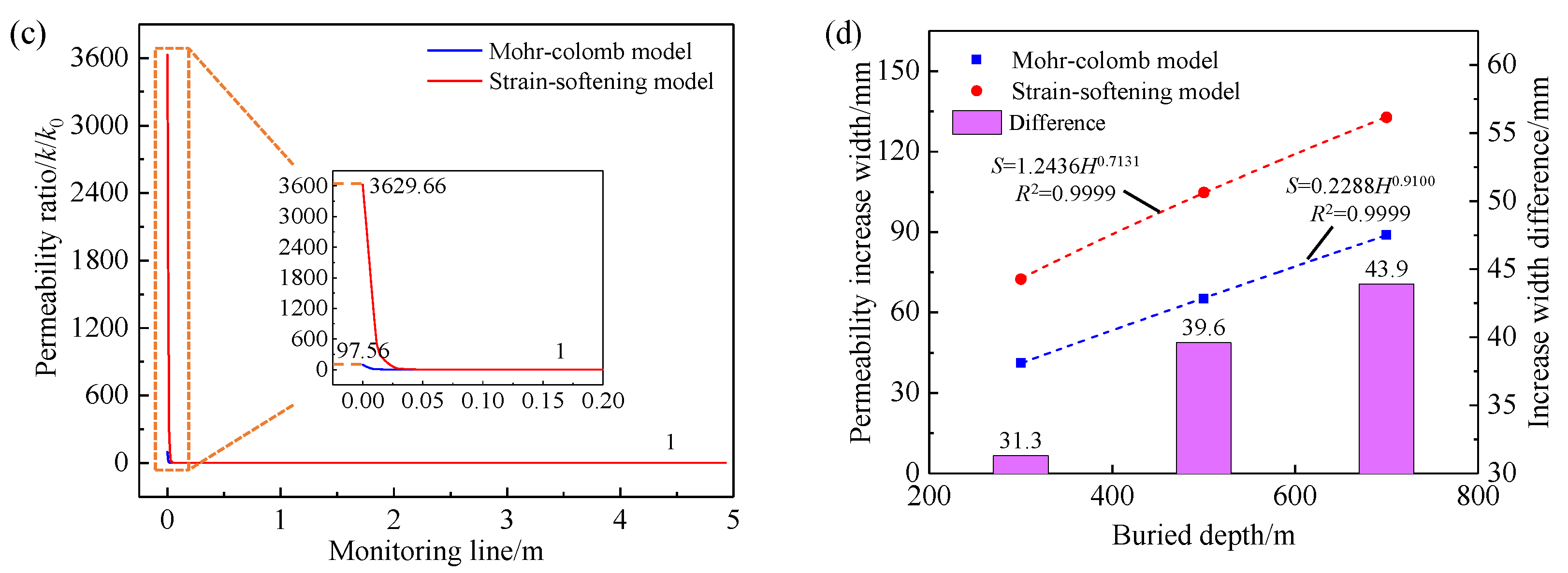




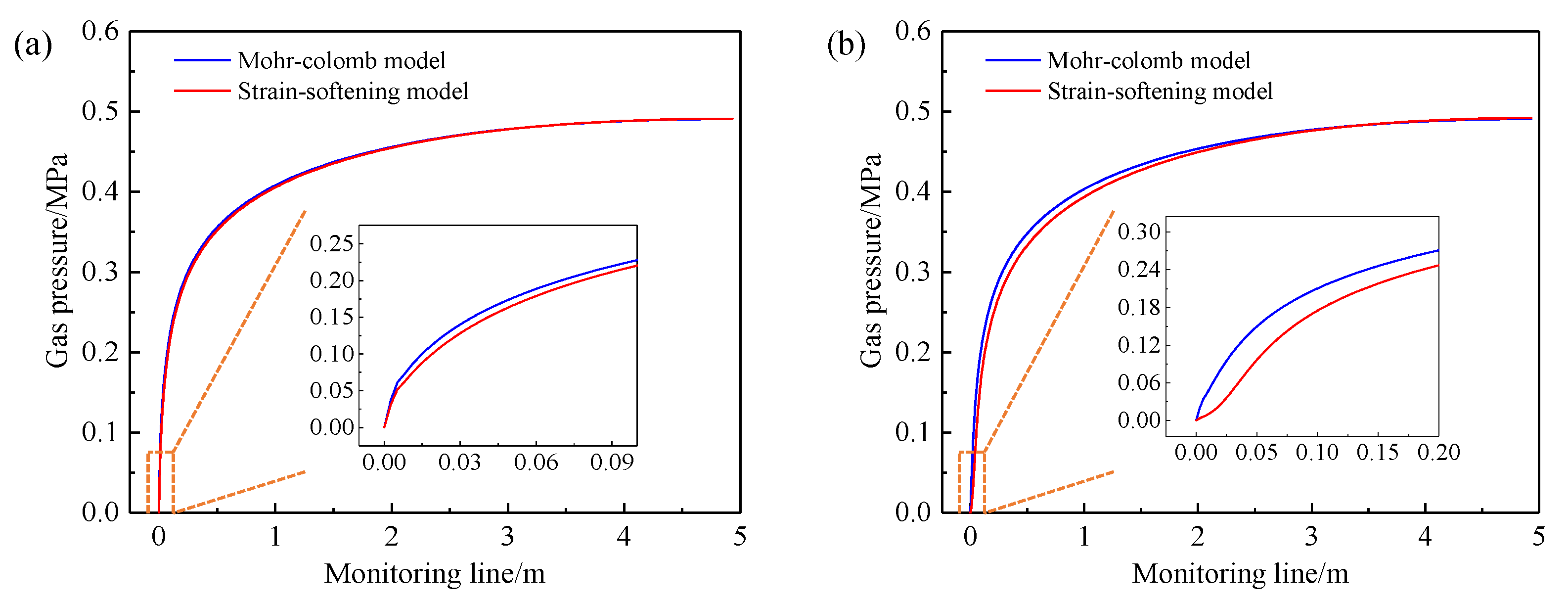
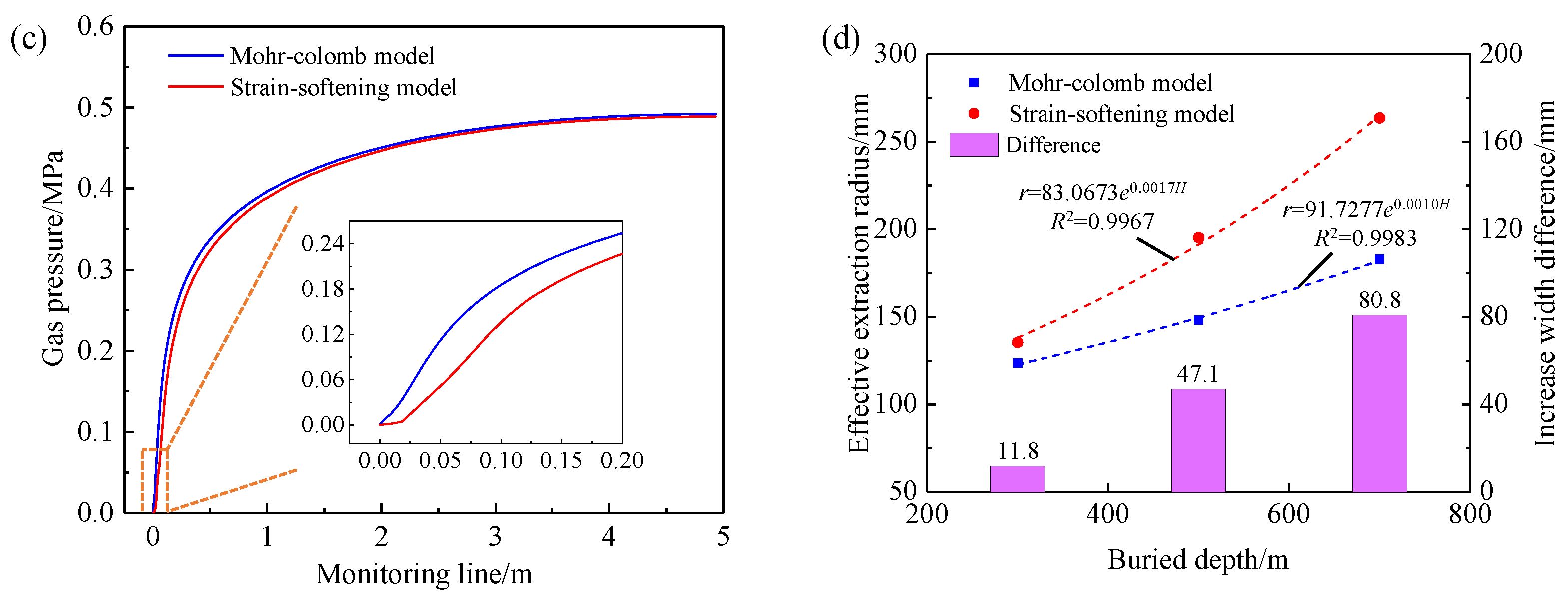
| Parameters | Value | Parameters | Value |
|---|---|---|---|
| Elastic modulus (E/MPa) | 1.2 | Original gas pressure (P0/MPa) | 0.5 |
| Internal friction angle (φ/°) | 30 | Adsorption time (τ/h) | 6 |
| Poisson’s ratio (υ) | 0.3 | Molar mass of gas (M/g·mol−1) | 16 |
| Density of coal matrix (ρc/kg/m3) | 1400 | Gas constant (R/J·mol−1·K−1) | 8.314 |
| Peak cohesion (cp/MPa) | 1.1 | Temperature of coal seam (T/K) | 293 |
| Residual cohesion (cr/MPa) | 0.6 | Maximum gas adsorption per unit volume of coal (VL/kg·m−3) | 24 |
| Original fracture porosity (ϕf0) | 0.04 | Molar volume of gas (VM/L·mol−1) | 22.4 |
| Original permeability (k0/m2) | 1.8 × 10−12 | Coal matrix porosity (ϕm) | 0.06 |
| Langmuir pressure constant (PL/MPa) | 1.0 | Viscosity of gas (μ/Pa·s) | 1.84 × 10−5 |
Disclaimer/Publisher’s Note: The statements, opinions and data contained in all publications are solely those of the individual author(s) and contributor(s) and not of MDPI and/or the editor(s). MDPI and/or the editor(s) disclaim responsibility for any injury to people or property resulting from any ideas, methods, instructions or products referred to in the content. |
© 2023 by the authors. Licensee MDPI, Basel, Switzerland. This article is an open access article distributed under the terms and conditions of the Creative Commons Attribution (CC BY) license (https://creativecommons.org/licenses/by/4.0/).
Share and Cite
Cui, J.; Zheng, Y.; Yan, X.; Hou, Y.; Xie, S.; Chen, D.; Ren, Y. Study on the Influence of the Strain-Softening of the Surrounding Rock with Buried Depth on Gas Extraction Boreholes. Processes 2023, 11, 1680. https://doi.org/10.3390/pr11061680
Cui J, Zheng Y, Yan X, Hou Y, Xie S, Chen D, Ren Y. Study on the Influence of the Strain-Softening of the Surrounding Rock with Buried Depth on Gas Extraction Boreholes. Processes. 2023; 11(6):1680. https://doi.org/10.3390/pr11061680
Chicago/Turabian StyleCui, Junqi, Yun Zheng, Xiangxiang Yan, Yunbing Hou, Shengrong Xie, Dongdong Chen, and Yuxin Ren. 2023. "Study on the Influence of the Strain-Softening of the Surrounding Rock with Buried Depth on Gas Extraction Boreholes" Processes 11, no. 6: 1680. https://doi.org/10.3390/pr11061680
APA StyleCui, J., Zheng, Y., Yan, X., Hou, Y., Xie, S., Chen, D., & Ren, Y. (2023). Study on the Influence of the Strain-Softening of the Surrounding Rock with Buried Depth on Gas Extraction Boreholes. Processes, 11(6), 1680. https://doi.org/10.3390/pr11061680






